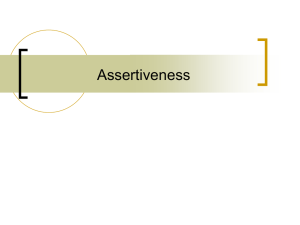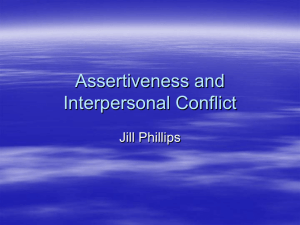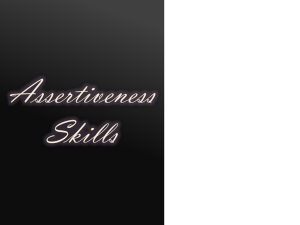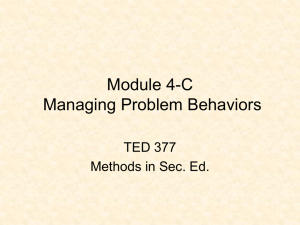Understanding Assertiveness
advertisement
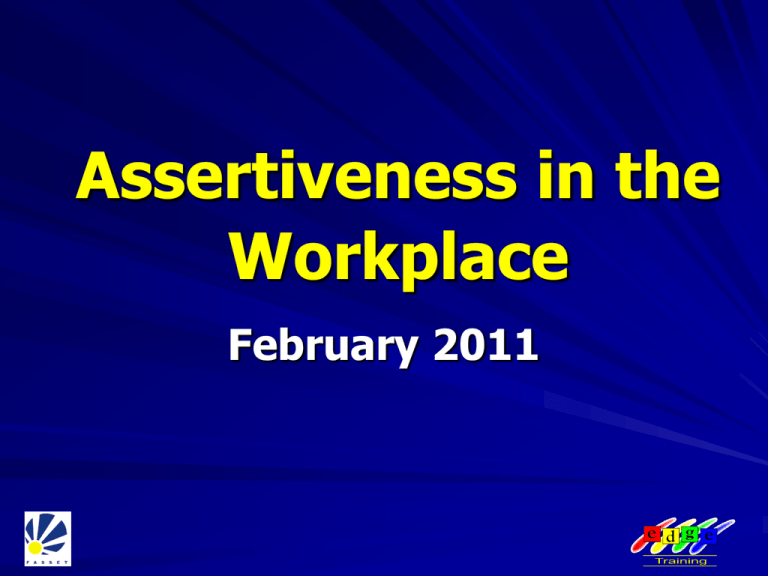
Assertiveness in the Workplace February 2011 Welcome and Introduction Our Days Agenda 08h30 – 09h00 Registration and Tea 09h00 – 10h30 Speaker Assertiveness in the Workplace 10h30 – 10h50 Tea Break 10h50 – 12h30 Assertiveness in the Workplace Continued 12h30 – 13h15 Lunch 13h15 – 14h30 Assertiveness in the Workplace Continued 14h30 – 14h50 Tea Break 14h50 – 16h00 Assertiveness in the Workplace Continued 16h00 Close Topic Agenda 1. Understanding assertiveness 2. How assertive am I? 3. Applying assertiveness in the workplace 4. Assertiveness and dealing with aggressive individuals 3 4 6 8 Understanding Assertiveness Communication Communication is the transfer of information, whether aggressively, passively or assertively by posture, words, facial expressions, tone or gestures, from one source to another, and in such a way that an understanding, whether intended or not, takes place. Understanding Assertiveness In his studies, Albert Mehrabian, the Professor Emeritus of Psychology at UCLA, identified that there are essentially 3 elements to communication, words, tone and body language. Words Tone Body Language Understanding Assertiveness In order for effective communication to take place it is important that the three elements are in congruence with one another. If people hear the words but see that our body language does not line up with what we are saying, they will be less likely to accept that what are saying is true. Mehrabian found that when the three elements were incongruent the listener was more likely to trust the predominate one. Understanding Assertiveness Understanding Assertiveness Understanding Assertiveness Understanding Assertiveness Understanding Assertiveness Now that we have identified the three means of communication, let us look at the three broad categories of communicators Aggressive Assertive Passive Understanding Assertiveness AGGRESSIVE Defining points • Standing up for what you believe in • Showing a lack of concern for what others believe in • Showing a lack of concern for the feelings and opinions of others. • Placing your needs and wants ahead of others Understanding Assertiveness AGGRESSIVE Typical statements of an aggressor “I will only say this once” “If I don’t do it, nobody will” “The only way to get things done properly is for me to do it” “I don’t really care what you think” “No, you will listen to me” Understanding Assertiveness PASSIVE Defining points • Failing to stand up for what you believe in • Allowing others to disregard what you think or believe • Allowing others to disregard your feelings and opinions • Placing the needs and wants of others ahead of your own Understanding Assertiveness PASSIVE Typical statements of a passive “No its ok, lets do it your way” “Whatever you think” “I’m not very good at this” “If its going to cause problems, rather let me do it” “I don’t mind” Understanding Assertiveness ASSERTIVE Defining Points Honest – Express yourself as you feel without lying to others as this is ultimately lying to yourself Considerate – Consider the situation you are in, the feelings and attitudes of others and express yourself appropriately within that context Direct – Be direct in your conversation so as to avoid the pitfalls of misunderstanding. Be clear, concise and deliberate with each statement Understanding Assertiveness Effective assertive communicators understand…. “Other people also have the right to be assertive in their behaviour style.” “A win/win scenario is always possible regardless of the behaviour style adopted by the other person.” Understanding Assertiveness Effective assertive communicators understand…. “You are not in a competition to change the other persons mind. They will change their mind only when they choose to change it.” “Other people are allowed to passionately believe something that is completely different to what you believe.” Understanding Assertiveness Effective assertive communicators understand…. “You are not always right.” “Any relationship requires commitment from both parties.” Understanding Assertiveness Effective assertive communicators understand…. “Proactive communication is always better than reactive communication.” “Assertiveness in the Workplace is a choice that I choose to make.” Understanding Assertiveness 7 Simple techniques for more effective listening 1. 2. 3. 4. 5. 6. 7. Maintain eye contact Respond appropriately with word or nod Refrain from interrupting Take notes if possible Allow the speaker to finish before evaluating the message Clarify main points with questions Keep emotions under control Understanding Assertiveness Why ask questions? • • • • • • • It builds understanding Promotes a higher level of thinking A person’s ability to understand & remember material is enhanced Questions encourage others to speak To collect information Able to find possible solutions Builds trust Understanding Assertiveness Benefits of open-ended questions: • • • • • Invites opinions, thoughts and feelings Encourages participation Establishes rapport Stimulates discussion Maintains balance between speakers Topic Agenda 1. Understanding assertiveness 2. How assertive am I? 3. Applying assertiveness in the workplace 4. Assertiveness and dealing with aggressive individuals 3 4 6 8 How Assertive am I? What can you do to be more Assertive? 1. Assertiveness is often linked to self image and self belief. Examine yourself first and know what your value system is. In knowing clearly who you are and understanding your rights, you will be able to communicate more directly and with confidence and self control. How Assertive am I? What can you do to be more Assertive? 2. Value the rights of others and be respectful of them. Understand that you may not always be right so open your mind to rational arguments. 3. Ask for help from peers who you know will be honest with you. How Assertive am I? What can you do to be more Assertive? 4. Identify the body language characteristics that you have that limit your effectiveness. These could take the form of giggling, nodding your head too much, playing with your hands or always averting the gaze of the person you are talking to. How Assertive am I? What can you do to be more Assertive? 5. Identify the tone characteristics you use that limit your effectiveness. A singing voice or a voice with a sarcastic undertone should be replaced by a level, well modulated tone. 6. Learn how to avoid being interrupted while you are talking by using a polite yet firm phrase. An example of this would be, “hang on, I haven’t finished” How Assertive am I? What can you do to be more Assertive? 7. Don’t start interactions with the word sorry. Also avoid apologising for what you are about to say. Both will immediately reduce the assertiveness factor. 8. Improve your listening skills and learn to ask effective open questions which will not only provide you with clearer information but improve your overall confidence with regard to the issue at hand. How Assertive am I? What can you do to be more Assertive? 9. Don’t be afraid to say no. If necessary give an explanation but don’t apologise through the entire explanation. This will be perceived as passivity and could be used against you to ultimately get you to say yes. 10.Use “I” not “you” statements. People cannot argue with how a situation makes you feel but they will argue with you if you tell them how it makes them feel, even if you are right! How Assertive am I? What can you do to be more Assertive? 11.Practise with friends and family. Practise in front of the mirror by making assertive statements, maintaining direct eye contact, standing relaxed and upright and be very aware of your tone and body language. Choose less anxious situations at first until you build up your confidence. Topic Agenda 1. Understanding assertiveness 2. How assertive am I? 3. Applying assertiveness in the workplace 4. Assertiveness and dealing with aggressive individuals 3 4 6 8 Applying Assertiveness in the Workplace Building Trust 1. 2. 3. 4. 5. 6. 7. 8. 9. Be Be Be Be Be Be Be Be Be honest open minded credible sincere timeous with information discreet transparent open humble Applying Assertiveness in the Workplace Employer Employee Get personally involved Get personally involved Involve the whole team and listen to others ideas and concerns. Allowing them to participate in the process will ensure their loyalty and commitment to the process. Share ideas and concerns remembering to always have an alternate idea if you believe something wont work. Participate fully and with enthusiasm in the process Ask for volunteers to assist with the process, you may be surprised as to who takes up the challenge. Build a team to assist with the process. Volunteer to assist with the process and be prepared to work in and work with a team. Be clear and honest about what needs to change and exactly how that process will take place. Plan well and keep all informed as to the progress. Listen carefully as to the changes and ask questions to avoid any confusion. Be positive and encourage others to improve. Be direct and clear as to why change is needed and exactly what that change will be. Be positive and supportive to those in charge and be an agent for change. Keep people informed with regular meetings. If you see that negativity is creeping in address it immediately by giving them a progress report. Attend all meetings and be positive. Take notes and address your peers when they speak negatively about the changes. Change Management Applying Assertiveness in the Workplace Dealing with Different Cultures In order to effectively communicate with another culture it is helpful if you understand their approach to: Authority – what is their approach to dealing with authority. Is it very hierarchical or very informal. Gender – how do they respond to members of the opposite gender in work relationships. Applying Assertiveness in the Workplace Time – are they time conscious or is the quality of the task more important. Detail – is great attention to detail important to them or are they more comfortable working in a creative environment. Individualism – do they believe in individualism or are the more collective in their approach to work. Age – how do they treat elders and how would they respond to instruction from a younger person. Topic Agenda 1. Understanding assertiveness 2. How assertive am I? 3. Applying assertiveness in the workplace 4. Assertiveness and dealing with aggressive individuals 3 4 6 8 Assertiveness and Dealing with Aggressive Individuals Dealing with aggressive individuals or bullies in the workplace can be a very intimidating. The reality is that that is exactly what an aggressor or bully wants you to feel. If you are intimidated and respond passively you reinforce the behaviour because as the bully gets their own way their behaviour is being rewarded which leads to it persisting. Assertiveness and Dealing with Aggressive Individuals 1. 2. 3. 4. 5. 6. Be prepared Don’t be dominated Don’t get offended – manage your emotions Ask clarifying questions Listen carefully Explain your action plan clearly Thank you …. Thank You Fasset Call Centre 086 101 0001 www.fasset.org.za
